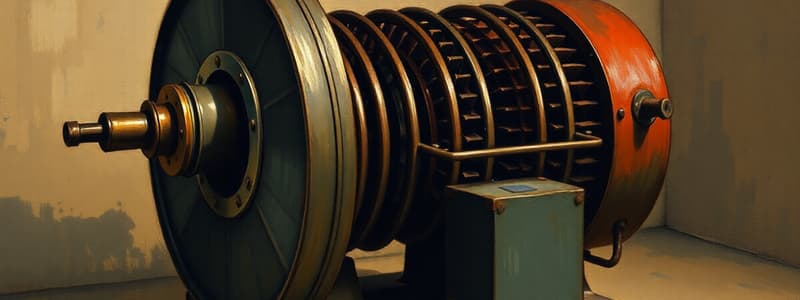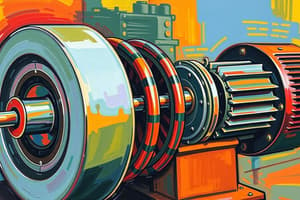Podcast
Questions and Answers
Which of the following is NOT a factor that affects the torque developed by an induction motor?
Which of the following is NOT a factor that affects the torque developed by an induction motor?
- Frequency of the supply voltage
- Rotor resistance
- Number of turns in the stator winding (correct)
- Rotor speed
The starting torque of an induction motor is typically higher than the full-load torque.
The starting torque of an induction motor is typically higher than the full-load torque.
True (A)
What is the breakdown torque of an induction motor?
What is the breakdown torque of an induction motor?
The maximum torque that the motor can develop.
The slip of an induction motor is defined as the difference between the ___________ speed and the ___________ speed.
The slip of an induction motor is defined as the difference between the ___________ speed and the ___________ speed.
Match the following types of induction motor starters with their descriptions:
Match the following types of induction motor starters with their descriptions:
Which of the following is NOT a method to control the speed of an induction motor?
Which of the following is NOT a method to control the speed of an induction motor?
A higher slip value generally corresponds to a lower rotor speed.
A higher slip value generally corresponds to a lower rotor speed.
Briefly describe one limitation of using a direct connection starter for induction motors.
Briefly describe one limitation of using a direct connection starter for induction motors.
Flashcards
Equivalent Circuit
Equivalent Circuit
A simplified representation of an electrical machine's functionality.
Starting Torque
Starting Torque
Torque at zero speed, typically 1.5 times full-load torque.
Pull-up Torque
Pull-up Torque
Minimum torque developed by the motor while accelerating from zero speed.
Breakdown Torque
Breakdown Torque
Signup and view all the flashcards
Torque-Speed Characteristics
Torque-Speed Characteristics
Signup and view all the flashcards
Slip
Slip
Signup and view all the flashcards
Types of Starters
Types of Starters
Signup and view all the flashcards
Speed Control of Induction Motors
Speed Control of Induction Motors
Signup and view all the flashcards
Study Notes
Electrical Machines: 3 Phase Induction Motor (Part 2)
- Equivalent Circuit: Three-phase induction motors have equivalent circuits per phase, allowing analysis of their performance. These circuits differ in frequency and number of turns.
- Equivalent Circuit Per Phase: Diagram shows components like resistance (r₁), reactance (X₁), magnetizing reactance (Xm), and resistance (Rₑ). These parameters are crucial for calculations.
- Exact Equivalent Circuit Per Phase Referred to Stator: This circuit representation explicitly includes rotor parameters, with the rotor resistance (r₂), referred to the stator. The value of r₂ is calculated as r₂ / s, where 's' is the slip.
- Exact Equivalent Circuit Per Phase Referred to Stator (Simplified): A further simplified equivalent circuit, showing the referred rotor resistance and parameters, is included. This simplified circuit includes an equivalent load resistance (r₂), and represents the motor's electrical behavior.
- Approximate Equivalent Circuit Per Phase Referred to Stator: This approximate circuit simplifies the model by combining some components. An equivalent circuit showing reactances (X₁) and (X₂) are combined to form Xeq. This is further simplified by including the load resistance and considering slip.
- Power Flow: Power flow diagrams illustrate the flow of electrical power within the motor. Different power losses like stator copper losses (Piron), rotor copper losses (Pcu2), iron losses (Pg), mechanical power (Pmg), and output power (Pout) are demonstrated. The diagram helps to determine the efficiency of the motor.
- Efficiency: Motor efficiency is calculated by dividing the output power (Pout) by the input power (Pin).
- Torque: Torque calculations are detailed, including shaft torque (Tshaft), developed torque (Tdev), mechanical torque (Pmg), and output torque. Concepts of synchronous speed (ns,) are included.
- Torque-Speed (Slip): Torque-speed characteristics are crucial to understanding motor operation. The curves demonstrate starting torque (Tst), maximum torque (Tmax), and the relationships with slip (s).
- Torque Points: Discussion of starting torque, pull-up torque, breakdown torque, and normal operation of the motor.
- Four Quadrants Torque-Speed: The behavior of the motor within different operating quadrants is presented. Different modes are explained (motoring, braking, generating etc) using graphs of torque versus speed.
- Effect of Rotor Resistance: Diagrams showing the torque-speed curves for different rotor resistance values are provided.
- Starting of Induction Motor: High starting current is a key phenomenon explained as the rotor acts like a short-circuited secondary.
- Types of Starters: Various starting methods are detailed, including direct connection, rotor resistance starter, auto-transformer starter, star-delta starter, and soft-starter. These methods reduce high starting current and increase starting torque.
- Auto-Transformer (cont.): Details regarding voltage, current and torque reduction while using an auto-transformer for starting.
- Star-Delta (cont.): Details regarding starting voltage, current and torque reduction using a star-delta starter.
- Soft-Starter: A method which utilizes thyristor-based control to regulate the voltage and current applied to the motor during starting, achieving a smooth acceleration.
- Types of Motor Loads: Different types of motor loads are outlined (constant torque, variable torque, constant power), and common examples in industrial settings are given.
- Speed Control of IM: Methods to change the speed of an induction motor are presented. Methods such as changing synchronous speed, changing slip are discussed, along with the impact on parameters like frequency, voltage, and rotor resistance.
- Adding External Rotor Resistance: Method of speed control using wound rotor motors, the effect of changing external rotor resistance on speed, torque and disadvantages of this method are discussed.
- Varying Supply Voltage: A method that involves controlling the supply voltage to regulate the motor's speed is discussed.
- Varying Supply Voltage and Supply Frequency: A method involving controlling both the supply voltage and frequency simultaneously explained. The benefit of keeping a consistent V/f ratio is highlighted.
- Pole Change Method: Details of a two-speed configuration in three-phase motors are provided.
- Speed Control (Direction): Interchanging phases in a three-phase motor results in reversing motor rotation.
- Motor Nameplate: Example format of a typical nameplate, providing electrical parameters and other important motor information is discussed:
- Squirrel cage vs slip ring motor: A table comparing squirrel cage motors with slip ring motors regarding differences, price, control methods, starting methods, starting torque, resistance, uses, and efficiency.
- Testing of IM: Methods for testing induction motors, including no-load and locked-rotor tests are defined. Instructions include conversion of readings to phase values, and using similar Transformer calculations to determine relevant parameters including Xm and R.
Studying That Suits You
Use AI to generate personalized quizzes and flashcards to suit your learning preferences.




